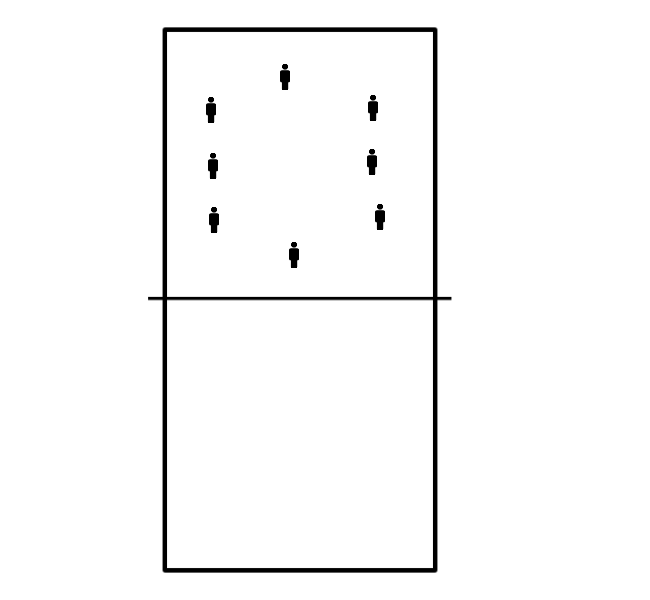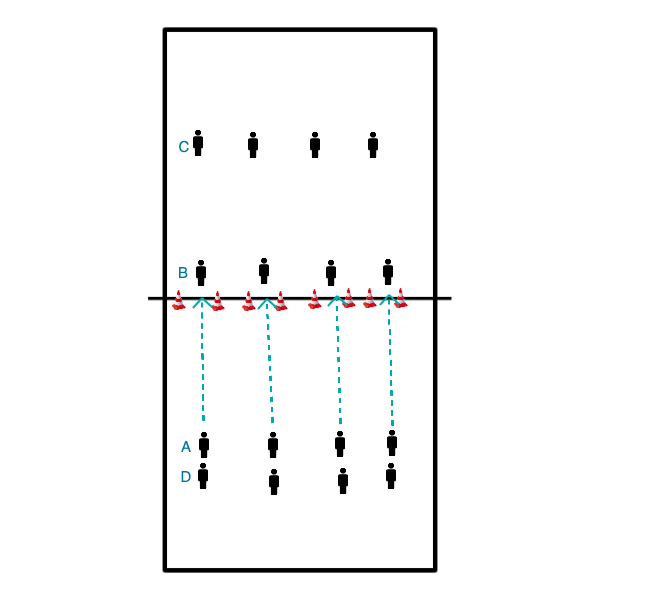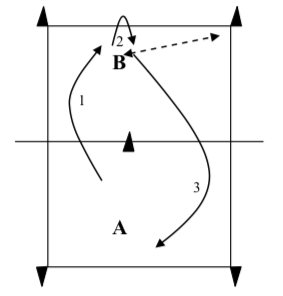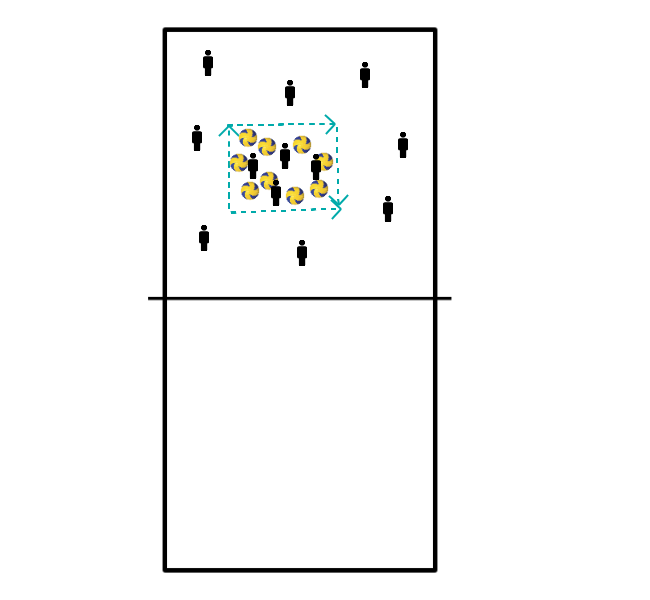Volleyball drills
Formation: circle/rectangle (on half a field)

- Dribble with right hand
- Dribble with left hand
- Alternate dribbling
- While dribbling, try to kneel down (knee by knee) --> sitting --> lying down
In pairs throwing the ball over in combination with body balance.
- Stand on 1 leg (solo exercise)
- Throwing with 2 hands
- Throwing with 1 hand
=> after each throw of the ball tap the ground (= bend forward + arms stretched = so tap the ground) + every 5 balls change legs per exercise
- Now throw the ball over with 2
- With 2 hands: pass from the neck via a bounce to the other
- With 1 hand: throw hard & tight.
- With other hand: throw hard & tight.
=> After action: each person has 2 jars + 1 tennis ball. When they have thrown the ball to the opponent, he/she moves the tennis ball from one pot to the other.
Per 2, each has a letter A or B. We walk through each other and on the signal A goes B tapping or vice versa, the trainer decides.
Walking Variations:
- Walk backwards
- Move sideways
- Cross pass
- Hopping
- Heels against seat
- Knees up
- ...
Tap variations:
- Crawling through the legs
- Hare over
- Walk around the person
- Tapping the heels
- Performing a clap game/routine
Setup: Each player has a ball.
Everyone walks through each other, bouncing a ball, and carries out the following tasks.
Signals + command
- On 1: bounce the ball to the right.
- At 2: bounce the ball to the left
- At 3: ba with both hands on collision
- Follow your way with the other hand.
- Pick up the ball with 1 or 2 hands after bounce
- Leave your own ball behind after bounce as quickly as possible to intercept another ball
More leaning towards keys:
- After dribbling ball catch own ball above head, then throw ball into air again without letting ball drop under eyes.
- Same as before, hold for 1 second
- Same as first, shorten contact
- Idem, but first catch the ball, then touch it away
- Ditto, but with double key
Game Form 1B:
During:
- The serve: the ball is thrown into play with both hands.
- Catching the ball with both hands above the head.
- Throwing the ball in front of himself (without dropping below the level of the eyes) and then overplaying it with an overhand touch.
Next:
- 2 feet out of the field, where the player wants: left - right - back
- Variation: touch a cone each time the ball crosses the net.
Notes:
- Throw the ball back where you caught it (do not run with the ball in your hands).
- Do not hold the ball in your hands for more than 2 seconds.
- Standing still when the ball is caught (and perhaps aiming).
Form 1C:
During:
- Picking the ball out of the air with one hand, making one collision and a second collision through a basketball dribble with one hand, high enough to play overhead. (One or two control keys may be used to play).
- Picking should be done as high as possible.
Next:
- 2 feet out of the court, where the player wants (left - right - back)
- Variant: move one of the two tennis balls placed on the 2 cones (at the back of the field).
- Everyone lines up in a plank position.
- The first person in the row
- rolls the ball under the others,
- goes to the other end of the line,
- rolls the ball back and joins them in plank position.
- The new first person takes the ball and does the same.
- In this way the different groups have to cover a certain distance as quickly as possible.
Formation: 2 balls per 4 players

1.
- Player A (bowling motion) rolls the ball to player B (the ball must pass between the 2 cones!!).
- Player B picks up the ball, bounces it 2 times and then plays it in a bow to player C.
- Player C holds a hoop and puts the hoop down at the spot where the ball is going to collide. The ball is caught after 1 collision. Player C grabs the ball and joins player D at the back.
- Everyone follows their ball = moves up one place.
2.
- Player A throws the ball under the net to player B.
- Player B catches the ball, bounces once high, does a control key and then bounces to player C.
- Player C catches the ball low to the ground in the correct reception position and runs to D to join the back of the line.
- Everyone follows their ball = moves up one spot.
3.
- Player A throws the ball (bowling motion!) over the net to player B.
- Player B plucks the ball out of the air, bounces 3 times (must turn around during those 3 bounces to face player C) and then tips the ball to player C.
- Player C does reception for himself and joins player D.
- Everyone follows their ball = moves up one spot.
4.
- Player A calmly strikes the ball underhand over the net to player B.
- Player B plucks the ball out of the air, does 1 control bounce, then does control keys until fully turned facing player C and then plays the ball player C.
- Player C does reception for himself, catches the ball and joins player D.
- Everyone follows their ball = moves up one spot.
In a line-up with 2 players facing each other, key the ball over the net after 2 dribbles and 1 high rebound.

Possible variations:
- Play the ball after bumps
- Playing the ball after picking
- Playing the ball after catching without bots
- Play with 2 balls
Note: depending on the level we can differentiate and let the better players play with a handicap.
Setup: 2 to 4 people in the square (made by, for example, 4 benches) with the balls, the rest around them.

- The people in the square throw the balls out of the square.
- The people around the square fetch the balls and throw/put them back in the square.
- The 'side' which, at the stop signal, has the least balls, has won.
variation on Kings Court: winners move to winners field, losers move out and 3 new players move in.
- 3 players per half (whole field)
- trainer puts 1st ball in field of new team
- max 2 plays per half
- no smashing, no jumping, no lobs
- communication per team is a necessity
- The whole field must be defended (is feasible).
- balls coming from the other side are not hard but placed.
- player1 throws in from behind the net:(3players)
- 2 teams on the back line on the stomach
- Player1 hits the ball, 2 players stand up and coach attacks one of the pair defends, nr. 2 sets up and nr. 3 attacks
- after that next 2 team player1 with player 2 etc.
- 2x around the field
- 3 times back and forth in a running pace to the net
- 3 times back and forth in runner's stride to the net, waving your arms while walking
- Cross walk to the net 3x (waving your arms along)
- 3x back and forth sideways to the net (arms swinging)







